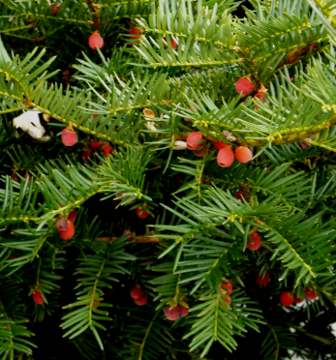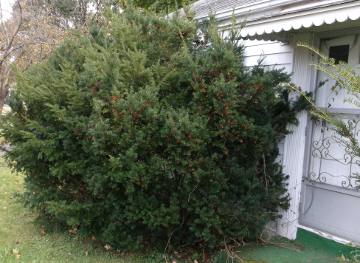 Taxus
baccata
Taxus
baccataEnglish Yew
This plant has a long association with death in European cultures. Ancient peoples made funeral wreaths dedicated to Hekate out of yew branches, and in the old Roman religion, black bulls to be sacrificed to Hekate were wreathed in it. Yew branches are laid upon the graves of the dead to remind us that death is a door. In some types of Christianity, it is planted around graveyards not only to remind visitors of eternal life but to keep the dead from wandering from their graves before Judgment Day. Some Norse Pagans believed that precisely because yew stood between two worlds, it could trap unwary souls inside itself. Yew's name comes from Eihwaz, the rune for the World Tree, Yggdrasil. The herb is associated with Yule, because as the Tree of Death as well as the Tree of Life, it represents a cusp between life and death, just as those two ideas dominate the holiday. Here we can clearly see the Saturn aspect of this plant in its preoccupation with borders (or in this case, with erasing those borders). Yew is also connected to Mercury, the teacher/trickster, in his capacity to travel between the worlds of the living and the dead. It is used ritually for work involving transformation, astral travel, necromancy, contacting ancestors, and in its connection to Mercury, for the acquisition of knowledge and skill with words. Yew can also be exceedingly long-lived. Certain specimens in Europe have exceeded well over 2000 years of growth. They are bushy, hardy, easily trimmed, and regularly used in topiary, which can sometimes hide their age. Few realize the quaint little hedge dividing their suburban plots could be centuries old.
Toxicity
Yew is commonly recommended for making runes, wands, and bows, and its wood is often beautifully figured. But yew is exceedingly poisonous. As an example, in the Middle Ages, John Baptist Porta recommended yew as a means for killing wolves, an arrow poison is made from it that kills animals instantly, 6-8 ounces can kill a cow or a horse, and people who have drunk wine stored in yew barrels have died. The berries are the only part that is not toxic, although the seeds inside the berries are. According to Plants for a Future guys, who have tasted the berries, they have a snotty texture and an insipid taste. However, in our opinion, this is one herb you should never ingest in any form, as it can easily be fatal. Although burning yew as an incense is still a traditional means for raising the dead and thus in a sense, entrapping them, you should burn it only outside, and even then take care not to inhale too much of the smoke. (Someone once emailed Alchemy Works saying even burning it outside could cause toxic effects.) Harold, founder of Alchemy Works, reports that one year putting up a storm window, he got some yew leaves down the back of his shirt without realizing it. When he got ready for bed, he found them--they had caused red welts on his back. The dried leaves smell good and can be dried just by leaving them outside over the winter, but drying actually increases the toxicity, probably because there is more alkaloid per plant material on account of the water having been evaporated. This is one of those plants that is great to grow but demands very careful handling. We recommend leaving it alone. The picture below shows one of the yews in front of Harold's old house which were formerly severely pruned into a box-shape. He let them grow and in five years they more than doubled in height and in width, thus sheltering his house from the north wind and summer heat. This is a lovely plant to admire, but once it gets established we suggest leaving it alone to do its thing and just enjoy its presence.
 How to Grow Yew
How to Grow Yew
The seeds is
very very slow to germinate, showing yew's deeply Saturnian nature. The
best way to do it is in spring to plant the seeds in a pot filled with
half potting soil and half sand or perlite, put a screen over the pot
that squirrels can't remove, and set the pot outside--for two winters.
This is why we have hesitated to carry yew seeds (it's usually
propagated from cuttings). But if you are patient, it will grow (if you
are going to propagate a slow seed like this, maybe do blackthorn as well).
Putting in the fridge for two years won't work--it needs the
fluctuating temperatures of outdoors--but apparently soaking the seeds
for 48 hours in cold (41F/5C) distilled water helps a little (when
pouring out the water, don't get it on your skin). Yew likes chalky
soils, which partly explains why it makes such a good foundation or
graveyard plant--it enjoys the chalkiness the soil gets from the cinder
blocks of a basement and from gravestones. Yew trees can live for 2000
years or more. In North America, however, they are generally found as
shrubs because of pruning. It is possible to prune the lower branches
off (dispose of them in your municipal yard waste center instead of
just tossing them somewhere, please); this encourages the plant to
taken on a tree form. The bark is quite beautiful, wrinkled and often
peeling, and branches are generally twisted and full of character. Good
for hedges and for topiaries, yew can be grown in containers and would
enjoy a concrete one. It can grow in most types of soil and just
doesn't like to be waterlogged, again demonstrating a Saturnian
preference for dryness over moisture. It is hardy to zone 6 (-5F/-20C).
General
growing info
Taxus
baccata
Yew
10 seeds $4.75
Uses in Witchcraft
& Magic:
Honoring Hekate/Hecate
Funerary Herb
Necromancy
Incense for Sorcery
Astral Work
Baneful Spells
Saturn/Mercury Plant
© 2014-2024 Alchemy Works; No reproduction without permission